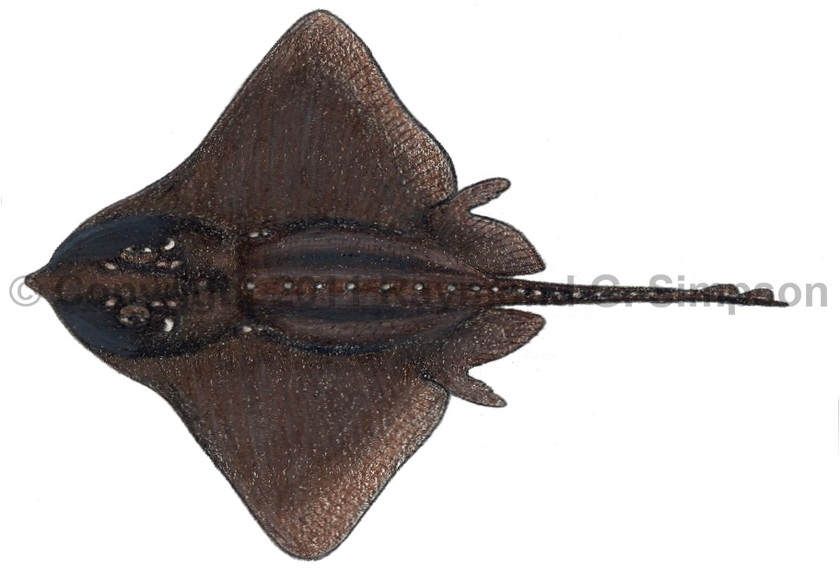
Common Name
Arctic Skate
Year Described
Collett, 1879
Identification
Body relatively thick and heavy. Disk diamond-shaped with a concave anterior margin (more so in males). Snout fairly short. Rostral cartilage stiff. Eyes small. Pectoral fins angular to bluntly rounded. Pectoral skeleton does not reach snout tip, leaving a semi-translucent area adjacent to rostral cartilage. Anterior pelvic fin lobe much smaller than the posterior lobe and separated by a shallow notch. Tail is thickened, about 64% of TL, and has skin folds on both sides. There are two dorsal fins, separated from each other by a distance less than first dorsal base. The caudal fin is very small. Upper jaw with 35-48 tooth rows. Clasper very stout and broad; reaches beyond dorsal fin.
Body covered with dermal denticles dorsally. Ventrum smooth. There are around 3 orbital thorns. There are 2-3 scapular thorns. There are 1-2 nuchal thorns. The abdomen and tail have a row of 22-32 thorns. Body thorns are very large, especially in young, with conspicuous stellate bases. Scattered small thorns on rest of body, including malar, alar patches (male), snout, base of pectoral fin, and bands on either side of tail. There are 0-1 thorns between the dorsal fins.
Color
Dorsum brown with a contrasting pattern of dark blotches and smaller pale spots. Tail banded with darker brown and pale-spotted interspaces. Ventrum variable: ranging from almost all gunmetal gray with small white patches to mostly pale whitish with random gray blotches. Young variable from heavily patterned to unpatterned.
Size
Maximum size to 112cm TL.
Habitat
Found at a wide variety of depths (160-3170m), but most common on deep abyssal plains. Captured in deeper water further south.
Range
In the W. Atlantic region appears to be restricted to the northwestern Atlantic from Arctic Canada and Greenland to New England. Records from the southern hemisphere not verified.
References
Last, P.R., White, W.T., Carvalho, M.R. de, Séret, B., Stehmann, M.F.W & Naylor, G.J.P (Eds.). 2016. Rays of the World. CSIRO Publishing, Melbourne.
Other Notes
Appears to be a widespread species found at both poles and extending into cold boundary regions further south in the North Pacific ( badia ) and North Atlantic ( hyperborea ). Identity of southern material uncertain.
There is a complex of similar skates in the genus Amblyraja in the Patagonian region that are difficult to separate using morphology and coloration is possibly the most useful character. The pale-bellied Amblyraja doellojuradoi and A. georgiana are partially sympatric in the Patagonian region with the latter being more common in the southern ocean. The existence of the widespread pale-bellied A. hyperborea in the South Atlantic is unclear and would complicate identification. Amblyraja frerichsi is sympatric with A. doellojuradoi but has a characteristic dark ventrum. Records of Amblyraja taaf in the SW Atlantic are misidentifications of other pale-bellied Amblyraja.